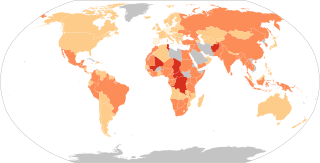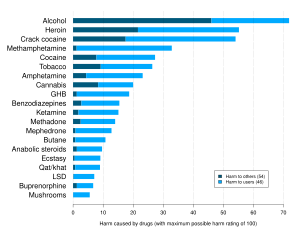
Flunitrazepam, sold under the brand name Rohypnol among others, is a benzodiazepine used to treat severe insomnia and assist with anesthesia. As with other hypnotics, flunitrazepam has been advised to be prescribed only for short-term use or by those with chronic insomnia on an occasional basis.

gamma-Hydroxybutyric acid is a naturally occurring neurotransmitter and a depressant drug. It is a precursor to GABA, glutamate, and glycine in certain brain areas. It acts on the GHB receptor and is a weak agonist at the GABAB receptor. GHB has been used in the medical setting as a general anesthetic and as treatment for cataplexy, narcolepsy, and alcoholism. The substance is also used illicitly for various reasons, including as a performance-enhancing drug, date rape drug, and as a recreational drug.
Incapacitating agent is a chemical or biological agent which renders a person unable to harm themselves or others, regardless of consciousness.
Sexual assault is an act in which one intentionally sexually touches another person without that person's consent, or coerces or physically forces a person to engage in a sexual act against their will. It is a form of sexual violence that includes child sexual abuse, groping, rape, drug facilitated sexual assault, and the torture of the person in a sexual manner.
Acquaintance rape is rape that is perpetrated by a person who knows the victim. Examples of acquaintances include someone the victim is dating, a classmate, co-worker, employer, family member, spouse, counselor, therapist, religious official, or medical doctor. Acquaintance rape includes a subcategory of incidents labeled date rape that involves people who are in romantic or sexual relationships with each other. When a rape is perpetrated by a college student on another student, the term campus rape is sometimes used.
A date rape drug is any drug that incapacitates another person and renders that person vulnerable to sexual assault, including rape. The substances are associated with date rape because of reported incidents of their use in the context of two people dating, during which the victim is sexually assaulted or raped or suffers other harm. However, substances have also been exploited during retreats, for example ayahuasca retreats. The substances are not exclusively used to perpetrate sexual assault or rape, but are the properties or side-effects of substances normally used for legitimate medical purposes. One of the most common incapacitating agents for date rape is alcohol, administered either surreptitiously or consumed voluntarily, rendering the victim unable to make informed decisions or give consent.
Victim blaming occurs when the victim of a crime or any wrongful act is held entirely or partially at fault for the harm that befell them. There is historical and current prejudice against the victims of domestic violence and sex crimes, such as the greater tendency to blame victims of rape than victims of robbery if victims and perpetrators knew each other prior to the commission of the crime.
A rape kit or rape test kit is a package of items used by medical, police or other personnel for gathering and preserving physical evidence following an instance or allegation of sexual assault. The evidence collected from the victim can aid the criminal rape investigation and the prosecution of a suspected assailant. DNA evidence can have tremendous utility for sexual assault investigations and prosecution by identifying offenders, revealing serial offenders through DNA matches across cases, and exonerating those who have been wrongly accused.
Date rape is a form of acquaintance rape and dating violence. The two phrases are often used interchangeably, but date rape specifically refers to a rape in which there has been some sort of romantic or potentially sexual relationship between the two parties. Acquaintance rape also includes rapes in which the victim and perpetrator have been in a non-romantic, non-sexual relationship, for example as co-workers or neighbors.
Sex and drugs date back to ancient humans and have been interlocked throughout human history. Both legal and illegal, the consumption of drugs and their effects on the human body encompasses all aspects of sex, including desire, performance, pleasure, conception, gestation, and disease.
Rape can be categorized in different ways: for example, by reference to the situation in which it occurs, by the identity or characteristics of the victim, and by the identity or characteristics of the perpetrator. These categories are referred to as types of rape. The types described below are not mutually exclusive: a given rape can fit into multiple categories, by for example being both a prison rape and a gang rape, or both a custodial rape and the rape of a child.

A drug-related crime is a crime to possess, manufacture, or distribute drugs classified as having a potential for abuse. Drugs are also related to crime as drug trafficking and drug production are often controlled by drug cartels, organised crime and gangs. Some drug-related crime involves crime against the person such as robbery or sexual assaults.

Rape is a type of sexual assault involving sexual intercourse or other forms of sexual penetration carried out against a person without their consent. The act may be carried out by physical force, coercion, abuse of authority, or against a person who is incapable of giving valid consent, such as one who is unconscious, incapacitated, has an intellectual disability, or is below the legal age of consent. The term rape is sometimes used interchangeably with the term sexual assault.
Sexual violence refers to a range of completed or attempted sexual acts in which the affected party does not or is unable to consent. Theories on the causes of sexual violence are numerous and have come out of many different disciplines, such as women's studies, public health, and criminal justice. Proposed causes include military conquest, socioeconomics, anger, power, sadism, traits, ethical standards, laws, and evolutionary pressures. Most of the research on the causes of sexual violence has focused on male offenders.

Alcohol and sex deals with the effects of the consumption of alcohol on sexual behavior. The effects of alcohol are balanced between its suppressive effects on sexual physiology, which will decrease sexual activity, and its suppression of sexual inhibitions.
Rape in the United States is defined by the United States Department of Justice as "Penetration, no matter how slight, of the vagina or anus with any body part or object, or oral penetration by a sex organ of another person, without the consent of the victim." While definitions and terminology of rape vary by jurisdiction in the United States, the FBI revised its definition to eliminate a requirement that the crime involve an element of force.
Rape investigation is the procedure to gather facts about a suspected rape, including forensic identification of a perpetrator, type of rape and other details.
Campus sexual assault is the sexual assault, including rape, of a student while attending an institution of higher learning, such as a college or university. The victims of such assaults are more likely to be female, but any gender can be victimized. Estimates of sexual assault, which vary based on definitions and methodology, generally find that somewhere between 19–27% of college women and 6–8% of college men are sexually assaulted during their time in college.

Alcohol-related crime refers to criminal activities that involve alcohol use as well as violations of regulations covering the sale or use of alcohol; in other words, activities violating the alcohol laws. Underage drinking and drunk driving are the most prevalent alcohol‐specific offenses in the United States and a major problem in many, if not most, countries worldwide. Similarly, arrests for alcohol-related crimes constitute a high proportion of all arrests made by police in the U.S. and elsewhere.

Drugs and sexual consent is a topic that discusses the impacts of drugs on sexual activity that lead to changes in sexual consent. Sexual consent is the voluntary agreement to engage in sexual activity, which is essential in preventing sexual violence. Consent can be communicated verbally or nonverbally and should be freely offered. However, drug use, particularly psychoactive drugs that alter mental processes, can affect people’s decision-making and consent communication ability, potentially impacting the autonomous aspect of sexual consent.







